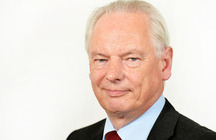Francis Maude – 2013 Speech on Digital Government

Below is the text of the speech made by the Cabinet Office Minister, Francis Maude, at the Queen Elizabeth II Conference Centre on 21st January 2013.
In just two decades, we’ve seen our world completely transformed by the digital revolution – email, online shopping, Wikipedia, Google, YouTube, Twitter, are now essential to our working and social lives.
Globally, over two billion people are online, with billions more set to join them in the next decade.
In the UK the vast majority – 82% – of us are online.
Unsurprisingly, the best entrepreneurs and businesses moved fast to grasp the opportunities of a digital age – these days, British Airways does everything online that isn’t about flying aeroplanes.
In contrast, government took a lot longer to get it. When you think of the benefits of the Digital Age – the plummeting costs of technology; the massive consumer choice; the exciting new innovations – unfortunately, you wouldn’t associate them with government services. In Whitehall, IT suppliers and system integrators have increased their costs. Yet services have remained patchy at best.
People who shop, bank and do their social networking online, interact with government on the phone, in person or on paper, at less convenience to them and at more cost to us. It’s a raw deal for everyone.
This government has made it a priority to bring Whitehall into the 21st century. And as you will see and hear today – the digital transformation of government has begun.
We are catching up with the private sector, with plans to build simple, fast, cost-effective online services that are designed around the user’s needs.
We are also changing the way we procure and run our technology systems – using a wider group of smaller, more innovative and more cost-effective suppliers.
And to ensure that these reforms succeed we are embedding digital expertise into our organisational DNA – building a Civil Service that is digital by default in our skills, style and how we communicate and deliver services.
Digital government
This kind of culture change doesn’t happen overnight. There is no doubt the Digital by Default agenda is a huge challenge – but it is also a huge opportunity.
I don’t need to remind you that we are living in constrained financial times – we’ve cleared a quarter of the huge deficit we inherited in two years, but the job isn’t done yet, and budgets across the public sector will continue to be tight.
At the same time consumer expectations for services are rising and we need to find new, innovative solutions so we can deliver more for less. The digital by default agenda will play a key role in this.
At the moment, government provides more than 650 transactional services serving about 1 billion users per year – but there are only a handful where a large majority of people who could use the online option do so. Half don’t offer a digital option at all – and apart from a handful of services, if there is a digital option few people use it because it’s not sufficiently fast or convenient.
This is clearly inefficient. For some government services, the average cost of a digital transaction is almost 20 times lower than the cost of a telephone transaction, about 30 times lower than the cost of a postal transaction, and about 50 times lower than a face-to-face transaction.
And it’s also a bad deal for customers, who increasingly expect to be able to use services at a time and place that’s convenient for them – digital is not just another channel, it is the delivery choice for this generation.
In the future, like the best businesses, we are committed to delivering services online wherever possible, to cut costs and put our customers in control.
This does not mean we will neglect the people who do not have online access – every single government service will still be available to everyone through our assisted digital programme, which will ensure no one is left behind.
But at the same time we are determined to build fast, clear, simple digital services that are so good that people who are online will choose to use them.
Digital strategy
In November I published a new Government Digital Strategy – an action plan for making us digital by default in everything we do, and departments have since published their own digital strategies setting out how they will transform their services.
This process is being kicked off by the seven main transactional departments – DfT, HMRC, Defra, DWP, BIS, Home Office and MoJ – who handle around 90% of all central government transactions.
Between them they will start work on transforming over 20 exemplar services by April this year, and the new digital services will be fully implemented by March 2015. By the end of the next Spending Review period (2018), we expect all government services handling over 100,000 transactions a year to be digital by default.
The first wave of services going digital include:
– a new and, for the first time, entirely online tax self-assessment service to make it easier for people doing tax returns
– to make it easier for people to volunteer we are planning a more straightforward online applications process for Disclosure and Barring Service (DBS) checks
– candidates for the National Apprenticeship Service will be able to search more easily for vacancies and apply online, while employers will be able to advertise vacancies and identify suitable candidates
– and entrepreneurs and businesses of all sizes will be able to register, track and manage patents and trade-marks and designs more swiftly and straightforwardly online with the Intellectual Property Office
These plans and many more are showcased today – what links each one is that these services are being redesigned around what users need to get done, not around the ways government want them to do it.
The government’s new single web domain, GOV.UK, which was launched last year, has led the way on this. GOV.UK is simpler, clearer and faster for users looking for government services and information. And it costs taxpayers at least £50 million less per year than the services it replaces.
The Government Digital Service will also be publishing a Digital by Default service standard that will describe what the new digital services must achieve. This will be released in April and from 2014 any service which fails to meet the standard will not be launched.
There is no expectation that this overhaul of the way we work and the services we deliver will be easy – but there are huge benefits. We estimate that by shifting the transactional services offered by central government departments from offline to digital channels we can make £1.2 billion of potential annual savings from now until 2015 and £1.7 billion a year beyond 2015.
Open government
On top of these savings, redesigning our services to be digital by default is also an opportunity to secure greater value for government, by changing how we commission and run our services.
In the past, government’s IT projects were too big, lengthy, risky and complex – plagued by budget overruns, delays and failures. Contracts were consistently awarded to a limited number of very large suppliers on long-term, exclusive contracts.
The result was huge amounts of money spent on government IT – as much as £20 billion a year based on some estimates – but a failure to deliver more digital, cost-effective, user-focused services.
Meanwhile, the UK’s burgeoning digital technology sector and its wide range of highly skilled and innovative companies, including many SMEs, were being shut out of the government procurement market; thanks to the high barriers to entry and complex, expensive and time-consuming bidding processes.
This is changing. We are moving away from legacy IT and our reliance on a few large system integrators. And introducing smaller contracts; shorter terms; a more diverse supplier community that is welcoming to SMEs; open standards; open source; and more use of commodity.
For example, government’s CloudStore, which allows public sector organisations to purchase a range of the best IT services off the shelf on a “pay-as-you-go” basis, rather than having to develop their own systems.
To date, there have been over £4m in sales of IT services through the CloudStore and, encouragingly, 60% of this spend, over £2m, has been with SMEs.
The Digital Strategy further sets out that the Cabinet Office will build on existing procurement reform to develop new commissioning arrangements for digital projects, to encourage a wider range of bidders, including SMEs, and a more competitive marketplace.
Civil service reform
Clearly, momentum is building on this agenda – but we have a lot further to go, and success hinges on us really bringing about a culture change in every corner of Whitehall.
Strong leadership will be essential. Every other industry which has transformed itself to survive and prosper in a digital age, from BA to Barclays, Amazon to M&S, has done so with innovative, entrepreneurial leadership driving those businesses.
I’m pleased to say all departments are now committed to establishing a digital leader with board-level clout to oversee their respective digital transformations. These leaders will need to be bold, pioneering and ready to challenge the status quo.
We are also recruiting skilled, experienced service managers – a new role in the civil service – who will be responsible for the new digital services, and they will be supported by specialist training from GDS.
But we realise we can’t just rely on a few people with specialist digital skills. We need to embed digital skills and awareness and enthusiasm at every level of the Civil Service.
This was a key priority set out in the Civil Service Reform Plan published last summer, and a number of actions are now being taken forward with some individual departments leading the way.
For example, MOJ have established a Digital Services Division to provide services such as strategic advice and specialist design and delivery skills. While BIS is conducting a full audit of departmental digital capability to ensure it has the skills required across the department and its agencies.
We are looking at incorporating digital skills into competencies and personal development plans for civil servants; building digital opportunities into future leaders’ and fast streamers’ development and developing a Civil Service-wide digital awareness programme.
And we are also considering options for digital apprentice schemes to support entry level digital skills within government.
These reforms, once implemented, will all help to build an exceptional 21st century civil service – capable of delivering the 21st century services that this country deserves.
Conclusion
For too long, the public sector lagged behind the private sector when it came to exploiting the opportunities of a Digital Age. Money was pumped into government IT – but this investment failed to deliver more efficient, user-friendly services.
Instead, government IT developed a reputation for big, costly failures.
The good news, as I’ve outlined today, is that this is changing. Thanks to the work of many individuals – including the government’s Digital Advisors from the business world, our UK Digital Champion Martha Lane Fox, and innovative Digital Leaders and civil servants within departments.
We are not where we need to be yet, but we will be – we are opening up to new technologies, innovative ideas and diverse business models for delivering better services for less money.
And, eventually, we are aiming to set a worldwide standard for digital delivery that other governments around the world will aspire to.
That’s our challenge – it will be difficult but it will be worth it. And I want to urge everyone working in government to get on board – be radical, pioneering and ambitious – as we build a digital revolution within Whitehall.

